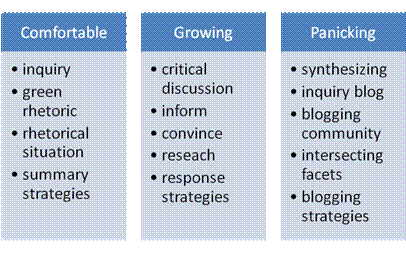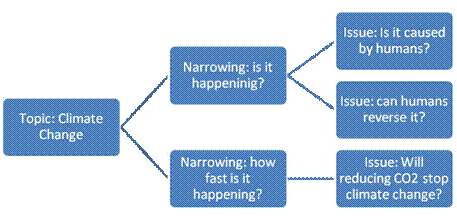Day 8 (Thursday, September 17th)
Lesson Objectives
Students will
Prep
You should review Leonard’s film and read “A Cautionary Video of America’s Stuff.” If you haven’t yet seen The 11th Hour, you might attend the campus viewing. You might review the movie either way and take some critical notes to inform your class discussion. On the movie website, http://wip.warnerbros.com/11thhour/, you’ll find a comprehensive list of topics that the movie covered. This would be an excellent source for today’s lesson.
Materials
Activities
Attendance and Lead-in (3-5 minutes)
Take attendance your usual way and introduce class, focusing on how today’s activities will help students understand the rhetorical situation of their upcoming assignment and will help them to better identify connections between texts by focusing on the issues texts present.
WTL Movie Review (5-10 Minutes)
This was done Tuesday, but in light of reading Kaufman’s article, it would be a good idea to see how thinking has shifted. With blogging growing in popularity, these days anyone can go out to the movies, come home, and become and “influential” critic on Twitter, Facebook, etc. Let’s write a movie review keeping in mind a specific rhetorical situation. In this case, you are the reviewer and you are writing to an audience of educators who are thinking of using the movie in their lesson plans.
Prompt: Educators should/shouldn’t use Annie Leonard’s movie, “The Story of Stuff,” because…
Ask students to provide specific reasons and details from the movie so you can collect the WTL and hold them accountable for the homework.
Ask students to compare this response to the response from Tuesday. Has their thinking been influenced and/or challenged in light of Kaufman’s article? Why might this be? What additional issues does Kaufman bring to light that you may not have considered and/or known about when initially viewing the movie?
Review Assignment 2 (2-5 minutes)
You might revisit the comfort circle metaphor. Today you will be focusing on two “panicking” concepts…synthesizing and intersecting facets.

Small group discussions (10 minutes)
In five or six small groups, ask students to get back into the groups they were in on Tuesday. Ask them to reconsider “The Story of Stuff,” and the New York Times article, “A Cautionary Video…” Ask them to finish their discussion by finding aspects of these texts that connect in some way to earlier readings from the semester (Quinn, Hawken, the Seed Panel, etc.) For example, is a rhetoric of doom emerging within the rhetoric of green? How about a rhetoric of hope? Which is louder?
The Rhetoric of Green…for children?
The movie and the article bring up the question of how the rhetoric of green is being framed for children.
Frame of Reference
Kaufman’s article presented much information about the context that Annie Leonard is writing in, including her background and expertise, or what we might call her frame of reference
Continuing the Conversation
One of the goals for assignment 2 is to keep the conversation surrounding the rhetoric of green alive and moving. This happens by finding concrete places for discussion.
Synthesizing Rhetoric
At this point we’ve read enough texts to begin identifying certain common themes within the rhetoric of green. Consider all of the reading we’ve done so far. Can you begin making concrete connections between ideas in the different texts?
Give students about 10 minutes to discuss and jot down answers to the questions, and then ask each group to present their findings, or have a whole class discussion to which each group contributes. Especially focus their attention on Continuing the Conversation as this helps students understand how texts engage and intersect with one another through specific issues.
Discuss The 11th Hour (30-35 minutes)
Ask students to take out their Rhetorical Situation Movie Guide and critical reading strategy (ie: double-entry log) to refer to in the class discussion. At this point in the class students should begin to make intertextual connections between the readings, films, and soon, the blogosphere. One way to begin making these connections is to identify topics within the green rhetoric conversation, and current debatable issues within those topics? The movie provides a rich list of possible topics to discuss within the conversation.
Use the tree below to convey to students how to distinguish between a topic and an issue. This is also a good time to encourage them to move their abstract thinking into the more specific realm where inquiry takes place.
Use the table to get students to come up with the current debatable issues within the broader topics.
Topic Narrowing Issues Issues

Topics: The following are topics covered in the 11th Hour Movie |
Issues: Within our rhetoric of green inquiry, what is being said—what debates, questions, and frames—within these topics, either in the movie or our other texts.
|
Environment and ecoliteracy |
Issues: |
Human thinking and human capacity |
Issues: |
Fresh water |
Issues: |
Oceans |
Issues: |
Air pollution |
Issues: |
Forests and lands |
Issues: |
Species & biodiversity |
Issues: |
Human health |
Issues: |
Environmental justice |
Issues: |
Civil society civilizations collapse |
Issues: |
OIL |
Issues: |
Economy and corporations |
Issues: |
Consumers and media |
Issues: |
Sustainable design |
Issues: |
Renewable energy |
Issues: |
Solutions from nature |
Issues: |
Individual action |
Issues: |
Religious perspectives |
Issues: |
Synthesis (8-10 minutes)
To complete this discussion ask students to look at some of the issues they came up with and think about the other texts they’ve read or viewed. Can they make some connections? Connections are happening at the topic level and at the issue level. Make sure students recognize the difference. For instance, over-consumption might be a topic addressed by multiple texts, but what people are suggesting we do about it might vary between texts (issue level).
Discussion: Clarifying Assignment 2 Goals (5-10 minutes)
One area where students will have confusion in this assignment is in determining the difference between initiating a critical discussion and making an argument. While their discussion might have minor contentions, it will not have an informed stance on a current debatable issue, backed up by logical reasoning and credible evidence (all in due time!) Rather this assignment asks students to gather bits of the conversation from different sources we’ve read/viewed and connect them in an engaging way that will enhance our understanding of the polyphony within the rhetoric of green. This exercise will begin to clarify the students’ purpose.
One way to split up the rhetoric at this point is by distinguishing between the rhetoric of problem and the rhetoric of solution. In other words, how do the various texts frame the problems within the rhetoric of green, and how do they frame the solutions.
Problems: How are these being portrayed? |
Solutions: How does the movie frame solutions? |
Solutions: How do other texts frame solutions? |
|
|
|
Intertextual Connection Example: Quinn says that humans have to change their way of thinking in order to be able to solve some major environmental problems. Did any experts in the movie say something similar?
Assign homework and conclude class (2-3 minutes)
Take time today to reiterate the importance of 1) having internet access for homework assignments, since we’ll be moving into analyzing blogs 2) bringing thorough notes to class, since you won’t have the blogs and films on hand.
Homework for Tuesday
Connection to Next Class
Today's class helped students begin to make important connections between the texts. Make sure that you continue to reinforce this synthesis as students struggle with “what to say,” in continuing the conversation assignment. You might remind students that you plan on returning their first major assignment on Tuesday, though don’t go so far as to make promises, since none of us can foresee extenuating circumstances that could prevent the assignment’s return.